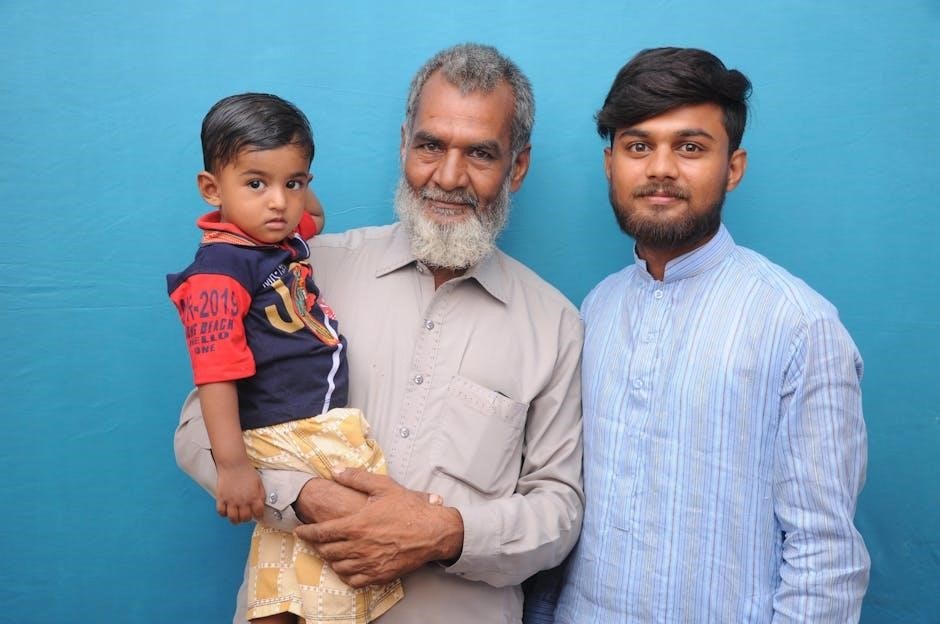
A Very Old Man with Enormous Wings: A Comprehensive Analysis

Gabriel Garcia Marquez’s “A Very Old Man with Enormous Wings” blends magical realism, exploring themes of faith, cruelty, and human indifference. The story, published in 1955, presents a decrepit winged man discovered by Pelayo and Elisenda, prompting reflection on human nature and societal responses to the extraordinary.
The narrative unfolds with Pelayo and Elisenda facing a relentless rainstorm, leading to the discovery of an old man with enormous wings in their courtyard; This mysterious figure, disoriented and seemingly senile, becomes an object of curiosity and exploitation for the townspeople. Initially perceived as an angel, his presence disrupts the mundane lives of the community, exposing their fickle faith and inherent cruelty.
As the news spreads, the old man attracts crowds, transforming Pelayo and Elisenda’s humble abode into a spectacle. The Church, skeptical of the supernatural, sends a priest to investigate, adding to the growing chaos. Amidst the frenzy, a spider-woman arrives, further diverting attention from the winged man. Over time, the novelty wears off, and the old man is gradually forgotten, left to his own devices in the corner of their chicken coop.
Eventually, the old man’s health deteriorates, mirroring the decay of faith and compassion within the community. However, he unexpectedly recovers, growing stronger and more vibrant. One day, he takes flight, soaring into the sky, leaving Pelayo and Elisenda to reflect on the strange episode that disrupted their lives. The ending is ambiguous, leaving the reader to ponder the true nature of the winged man and the significance of his visit.

Magical Realism in “A Very Old Man with Enormous Wings”

Gabriel García Márquez masterfully employs magical realism in “A Very Old Man with Enormous Wings,” seamlessly blending fantastical elements with the ordinary. The story presents a world where the supernatural intrudes upon the mundane, blurring the lines between reality and fantasy. The presence of an old man with wings, a clear deviation from the natural order, is accepted with a degree of normalcy by the characters, highlighting the genre’s defining characteristic.
The narrative avoids explicit explanations or justifications for the extraordinary events. Instead, Márquez focuses on the characters’ reactions and the societal impact of these occurrences. The old man’s wings, though fantastical, are described with realistic detail, making him both extraordinary and strangely believable. This juxtaposition of the magical and the real creates a sense of wonder and invites readers to question the boundaries of perception.
Furthermore, the spider-woman, a character transformed into a spider for disobeying her parents, exemplifies magical realism’s ability to incorporate mythical and supernatural elements into everyday life. The story’s power lies in its ability to portray these extraordinary events as commonplace, prompting reflection on the nature of faith, human behavior, and the acceptance of the inexplicable within the fabric of reality.
Character Analysis: The Old Man with Wings
The old man with enormous wings is a central figure in Gabriel García Márquez’s short story, embodying ambiguity and provoking diverse interpretations. He appears as a disoriented, decrepit being, discovered in a muddy courtyard after a storm. His physical state is far from angelic, described as balding, nearly toothless, and dressed in rags. The wings themselves are not pristine symbols of divinity, but rather dirty and threadbare, suggesting a fallen or degraded state.
His inability to communicate clearly, speaking an unintelligible dialect, further contributes to his enigmatic nature. He is more of an oddity, a freak of nature, than a supernatural entity in the eyes of the townspeople. Despite his extraordinary wings, he is treated with indifference and even cruelty, subjected to curiosity and exploitation rather than reverence.
The old man’s passivity and apparent helplessness raise questions about his true nature. Is he a fallen angel, a symbol of lost faith, or simply a vulnerable, misunderstood creature? His presence challenges the conventional notions of angels and miracles, presenting a more human, flawed, and ultimately ambiguous figure. He evokes pity and discomfort, forcing readers to confront their own perceptions and expectations of the divine.
Pelayo and Elisenda: A Study of Human Nature
Pelayo and Elisenda, the couple who discover the old man with wings, serve as a microcosm of human nature in Gabriel García Márquez’s tale. Initially, they are driven by practicality and self-interest, their primary concern being their sick child. The discovery of the winged man becomes an opportunity for financial gain rather than a moment of spiritual awakening.
Their treatment of the old man reflects a blend of curiosity, exploitation, and indifference. They confine him to a chicken coop, treating him more like a strange animal than a divine being. As the crowds flock to see him, Pelayo and Elisenda profit from the spectacle, highlighting the human tendency to capitalize on the unusual and the vulnerable.
Over time, their initial fascination wanes, and the old man becomes a nuisance, a symbol of their stagnant lives. Elisenda, in particular, views him as an annoyance, a constant reminder of the extraordinary in their mundane existence. Their ultimate relief at his departure underscores the human desire for normalcy and the ease with which the extraordinary can become ordinary, even burdensome. Pelayo and Elisenda’s actions expose the complexities of human nature, revealing a capacity for both compassion and cruelty, faith and skepticism.
Themes: Faith and Doubt
“A Very Old Man with Enormous Wings” intricately explores the themes of faith and doubt through the reactions of the townspeople to the arrival of the winged man. Initially, the villagers are uncertain about his identity, oscillating between the belief that he is an angel and the suspicion that he is a mere mortal or a demonic figure. This uncertainty highlights the fragility of faith in the face of the inexplicable.
The local priest’s insistence on verifying the old man’s angelic status through the Vatican underscores the institutionalization of faith and the reliance on external authority for validation. The story satirizes the tendency to seek definitive proof of the divine, even when confronted with the extraordinary. As the old man fails to perform miracles or exhibit traditionally angelic qualities, the villagers’ faith dwindles, replaced by indifference and a search for more sensational distractions.
Ultimately, the story suggests that true faith lies not in seeking tangible proof or adhering to rigid doctrines, but in embracing the mystery and ambiguity of the unknown; The old man’s presence challenges the villagers’ preconceived notions of the divine, forcing them to confront their own doubts and limitations. The story suggests that faith, in its purest form, may require accepting the extraordinary without demanding definitive answers.
Themes: Human Cruelty and Indifference
Gabriel García Márquez’s “A Very Old Man with Enormous Wings” vividly portrays the themes of human cruelty and indifference through the villagers’ treatment of the enigmatic winged man. Initially viewed as a spectacle, the old man is subjected to various forms of mistreatment, highlighting humanity’s capacity for both casual and deliberate cruelty.
The villagers poke and prod him, treating him more like a caged animal than a sentient being. Their fascination quickly turns to boredom, and the old man becomes a source of amusement and exploitation. Pelayo and Elisenda, the couple who discover him, confine him to a chicken coop and charge admission for others to gawk at him, demonstrating a callous disregard for his well-being.
The arrival of the spider-woman further diminishes the old man’s significance, as the villagers’ attention shifts to the more sensational attraction. This illustrates humanity’s fickleness and its tendency to prioritize novelty over compassion. The story underscores the dangers of dehumanization, showing how easily individuals can become objects of ridicule and neglect when they are perceived as different or powerless. Ultimately, the old man’s suffering serves as a stark indictment of human nature’s darker aspects.
The Significance of the Wings
In Gabriel García Márquez’s “A Very Old Man with Enormous Wings,” the wings themselves are laden with symbolic weight, yet their meaning remains deliberately ambiguous. They immediately signify the supernatural, hinting at angelic origins or a connection to a realm beyond human comprehension. However, the wings are described as being dirty, tattered, and infested with parasites, challenging conventional notions of angelic purity and grace.
This degradation of the wings can be interpreted as a representation of the corruption or loss of faith in the modern world. The old man’s inability to perform miracles or offer profound wisdom further undermines any expectations of divine intervention. The wings, therefore, become a symbol of unfulfilled potential, a reminder of humanity’s yearning for transcendence that is ultimately grounded in earthly limitations.
Furthermore, the villagers’ varying reactions to the wings highlight their own individual beliefs and prejudices. Some see them as a sign of hope, while others view them as a grotesque deformity. Ultimately, the significance of the wings lies not in any inherent quality, but in the projections and interpretations imposed upon them by the human characters, reflecting the subjective nature of faith and perception.
Satire of the Catholic Church
García Márquez employs satire to critique the Catholic Church’s bureaucracy and detachment from genuine spiritual needs in “A Very Old Man with Enormous Wings.” The local priest, Father Gonzaga, embodies this critique through his reliance on rigid dogma and procedure. Instead of offering compassion or spiritual guidance, he focuses on determining the old man’s identity through superficial means, such as examining his language and physical attributes, highlighting a concern with external validation over internal faith.
The Church’s inability to recognize or understand the “angel” underscores its failure to address the deeper existential questions of the community. Father Gonzaga’s consultation with higher authorities in Rome further emphasizes the Church’s slow, bureaucratic nature, rendering it ineffective in responding to immediate human concerns. The Church’s preoccupation with verifying the old man’s authenticity contrasts sharply with the villagers’ more practical, albeit often exploitative, reactions.
Ultimately, the story suggests that the Church has become more concerned with maintaining its authority and adhering to tradition than with fostering genuine spiritual connection, revealing a disconnect between the institution and the true essence of faith, mirroring a broader societal critique of organized religion’s role.
Symbolism of the Spider-Woman
The spider-woman in “A Very Old Man with Enormous Wings” serves as a contrasting symbol to the old man, offering an alternative spectacle that captivates the villagers’ attention. Her transformation, a consequence of disobeying her parents, represents a tangible and easily digestible explanation for the extraordinary, unlike the enigmatic presence of the winged man. The spider-woman’s story is presented as a cautionary tale, highlighting the human tendency to seek simple narratives and moral lessons, even when faced with the inexplicable.
The villagers’ shift in interest from the old man to the spider-woman underscores their fickle nature and their preference for sensationalism over genuine contemplation. While the old man embodies a sense of mystery and potential transcendence, the spider-woman offers a clear cause-and-effect relationship, appealing to their desire for easily understandable explanations. This transition highlights a societal inclination towards readily available entertainment and superficial narratives, often at the expense of deeper engagement with complex or ambiguous phenomena.
Ultimately, the spider-woman symbolizes the allure of the sensational and the tendency to prioritize easily digestible stories over profound, albeit unsettling, encounters. She represents a distraction from the more profound questions raised by the old man’s presence, reflecting humanity’s preference for the readily explainable over the mysterious and unknown.
Narrative Style and Structure
Gabriel García Márquez employs a distinctive narrative style in “A Very Old Man with Enormous Wings,” characterized by magical realism, blending fantastical elements seamlessly into an otherwise ordinary setting. The story unfolds with a straightforward, almost journalistic tone, presenting the extraordinary—an old man with wings—as a matter-of-fact occurrence. This juxtaposition of the mundane and the miraculous is a hallmark of Márquez’s writing, creating a sense of wonder and absurdity.
The narrative structure is relatively simple, following a chronological sequence of events. The story begins with the discovery of the old man and progresses through the villagers’ reactions, the exploitation of his presence, and his eventual departure. This linear structure allows Márquez to gradually reveal the themes of the story, such as human cruelty, indifference, and the search for meaning in the face of the inexplicable.
Furthermore, the narrative voice is detached and objective, refraining from explicit judgment or emotional commentary. This objective perspective allows the reader to form their own interpretations of the events and characters, enhancing the story’s ambiguity and encouraging critical reflection on the human condition. The unadorned prose contributes to the story’s unsettling effect, forcing the reader to confront the strangeness of the situation without the comfort of a guiding moral voice.
The Ending: Departure and Ambiguity

The conclusion of “A Very Old Man with Enormous Wings” is marked by the old man’s eventual departure, leaving behind a sense of ambiguity and lingering questions. After enduring years of neglect and exploitation, the old man’s wings gradually recover, and he eventually flies away, disappearing over the horizon. This departure is not presented as a triumphant ascension or a miraculous event but rather as a natural, almost unremarkable occurrence.
The ambiguity lies in the lack of resolution regarding the old man’s true nature and purpose. Is he an angel, a fallen being, or simply a strange, misunderstood creature? The story offers no definitive answers, leaving the reader to grapple with these questions. The villagers’ reactions to his departure are also ambiguous, ranging from indifference to a vague sense of relief.
Elisenda, who initially found the old man repulsive, experiences a moment of bittersweet recognition as she watches him fly away. This fleeting moment suggests a possible shift in her perspective, but it is quickly overshadowed by the return to her ordinary life. The ending reinforces the story’s central themes of human indifference and the fleeting nature of wonder. The old man’s departure leaves a void, but life continues, highlighting the human tendency to prioritize the mundane over the extraordinary.
Interpretations: Angel or Just an Old Man?
The central ambiguity of Gabriel Garcia Marquez’s “A Very Old Man with Enormous Wings” lies in the question of the old man’s true nature: is he an angel, or simply a decrepit old man with unusual appendages? The story deliberately avoids providing a definitive answer, inviting multiple interpretations and fueling scholarly debate.
Those who interpret him as an angel often point to the supernatural element of his wings and the initial assumption by some villagers that he is indeed an angel. However, his unkempt appearance, his inability to communicate clearly, and his apparent lack of divine powers challenge this interpretation. He exhibits more human frailties than angelic qualities, leading some to believe he is a fallen or degraded angel, a symbol of diminished faith.
Alternatively, the old man can be seen as a metaphor for the extraordinary within the ordinary. His wings, regardless of their origin, set him apart from the mundane reality of the village. He becomes an object of curiosity and exploitation, reflecting humanity’s tendency to commodify and misunderstand what it cannot comprehend. This interpretation emphasizes the story’s critique of human nature and its exploration of how society treats the “other.” Ultimately, the ambiguity surrounding the old man’s identity is crucial to the story’s enduring power, prompting readers to question their own perceptions of the supernatural and the human condition.
Critical Reception and Legacy
Gabriel García Márquez’s “A Very Old Man with Enormous Wings” has garnered significant critical acclaim and established a lasting legacy in the realm of magical realism. The story’s publication in 1955 marked an early example of Márquez’s signature style, blending fantastical elements with the everyday realities of Latin American life.
Critics have lauded the story for its insightful commentary on human nature, its satirical portrayal of societal responses to the extraordinary, and its exploration of themes such as faith, compassion, and exploitation. The ambiguity surrounding the old man’s identity has also been a focal point of critical analysis, with scholars offering diverse interpretations that range from religious allegory to social critique.
The story’s impact extends beyond academic circles, as it has become a widely read and studied work in literature courses around the world. Its accessible narrative and thought-provoking themes resonate with readers of all ages and backgrounds. “A Very Old Man with Enormous Wings” has also been adapted into various forms, including film and theatre, further solidifying its place in popular culture. Its enduring appeal lies in its ability to challenge conventional notions of reality and to prompt reflection on the complexities of the human experience, cementing Márquez’s position as a master storyteller and a significant voice in 20th-century literature.